New Translink tax means emptier pockets for students
January 15, 2010 by Kristi Jut · 1 Comment
Kwantlen students got slapped with a parking-fee increase when they went back to school from their winter break on Monday, Jan. 4.
Parking rates have risen from $2.75 for every four hours to $3.25. For all-day parking at any of the campuses, it now costs students $4.75 instead of the $4.
Julian Jones, vice-president of business development at Impark, said the company isn’t collecting any extra revenue from the increase as it’s a result of a tax-hike introduced by Translink. He does, however, admit that “sometimes numbers have to be tweaked for a more user-friendly method of payment.â€
The tax that Impark now pays to Translink, which took effect Jan. 1, has risen from seven per cent to 21 per cent and is a 300 per cent jump from 2009.
“Since the tax on $1 is 21 per cent, we can’t really charge 21 cents on that. It has to be something more convenient, like 25 cents,†said Jones. Gordon Lee, Kwantlen’s vice-president of finance and administration, said that students can expect another fee increase when the HST (harmonized sales tax) comes into effect in July.
“Kwantlen has been working with Impark for about 10 years and they’ve managed the lot since they won [the rights to the lots] through a bid,†said Lee. “The cost [of parking] goes towards servicing the lot. There are no revenues that the school collects.â€
According to Lee, about 15 years ago, students didn’t have to pay to park on campus, but they had to start charging for parking “as the budget got tighter.â€
“The thing is,†said Lee, “we don’t get money to make parking lots. But it is required that schools have parking lots that are safe and maintained.â€
Instructor’s fast food free verse gets radio airtime
January 15, 2010 by Jacob Zinn · Leave a Comment
Billeh Nickerson’s three-month stint in fast food some 20 years ago now has him busy until August on a nationwide book tour.
This week, the Creative Writing instructor discussed his new book, McPoems, with Shelagh Rogers on the CBC radio show The Next Chapter. The book is a collection of poetry written about his time in the fast food service industry.
“All the poems are second-person and they situate the reader behind the counter,” said Nickerson, who worked at a well-known fast food restaurant in Langley while he was a Kwantlen student.
“There’s poems about French fries and ice cream cones and people freaking out about finding pickles on their burgers when they didn’t want pickles.”
Though complaining customers are a part of the job, Nickerson chose to focus more in the lighter side of fattening food chains, such as colourful regulars and co-workers having fun.
“I didn’t want pick a necessarily rhetorical stance because that’s happened with Fast Food Nation and Super Size Me,” said Nickerson. “I just wanted to have a focus on images and stories and let the reader make their own decision.”
Here’s a sample from McPoems, titled “Twist Cone.”
Your co-worker sings “Ebony and Ivory” every time she makes a twist cone
“It’s like chocolate and vanilla,” she tells you repeatedly
So often, you begin to hate pianos
almost as much as twist cones,
the people who order them,
and co-workers who sing
Nickerson had fun with the design of the book as well. The front cover is made to look like a Big Mac and the author’s photograph is his employee-of-the-month photo from July 1989, which his parents kept and gave to him a few years ago.
The interview aired on Monday and will be repeated on Saturday, Jan. 16 at 4 p.m. on CBC Radio One, 690 AM.
KSA jokingly takes alcohol seriously
January 15, 2010 by Jacob Zinn · 1 Comment

Sebastien Bergeron displays a bottle of Sleeman's at the Grassroots Cafe. (Jacob Zinn photo)
When the Grassroots Cafe got its liquor license, the KSA developed a group to select the beer that would be served in the cafe. That group was the Beer and Girly Drinks Committee.
The reason for the name?
“It was funny. I think that was it,” said John O’Brian, the KSA Cloverdale Assembly Coordinator.
Nathan Griffiths, the KSA Director of Operations and former co-chair of the Beer and Girly Drinks Committee, said, “At this point, it’s just a funny, quirky thing that’s become part of the culture of the society.”
While the group has succeeded in getting sponsorships with Okanagan Spring Brewery, Sleeman Breweries and Dos Equis, there aren’t any “girly drinks” available. The committee is looking into those, but also says that despite the committees name, manly drinks are not excluded.
However, beer and girly drinks aren’t the only concerns that the KSA deemed worth their own oddly-named committee.
When Ashley Fehr realized the abbreviation for the Academic Issues Committee sounded like “ache,” she felt the committee needed a name change. That’s what prompted the strange name of the Friends and Knights Tackling All Scary/Terrifying Issues/Crises.
Abbreviated, that’s FANTASTIC (The “k” in “Knights” is lowercase and the “n” is uppercase.)
“I was like, all the committees should be awesome words,” said Fehr. “That’s why I decided to make mine FANTASTIC, because if you’re a fantastic committee, then hopefully you can do fantastic things.”
As the Director of Academics, Fehr said that despite the change, the KSA still tackles important academic issues.
“It was not meant to say academic issues aren’t serious,” she said. “We just wanted to do something fun, lighten the mood a bit because before it sounded like ‘ache’ and that’s not very inspiring.”
FANTASTIC will soon go through another name change as the group will become a student senate. One member from each academic and social club will become a member of the senate and they will hold discussions on academic issues.
“The student senate, in my opinion, in my vision, would still talk about those issues as well,” said Fehr. “It would just have a broader scope of what other students think about it instead of just council members who generally are like-minded individuals.”
Charity event for Big Brothers will be a circus
January 15, 2010 by Mitch Thompson · Leave a Comment
Kwantlen’s second-year public relations students will be putting on a fund-raising event for Big Brothers of Greater Vancouver on Feb. 9.
The event, “Circus of the Night,” is a circus-themed benefit, featuring music, an illusionist and both a live and silent auction.
“We chose Big Brothers because it is a well-respected organized charity that is important to society,” said Natalie Burgwin, PR student and one of the events organizers.
Although the fundraiser is part of the student’s course work, they said that it’s not about grades.
“We’re not just doing it to pass a course,” said organizer Ashley Letts. The event and charity are something they really believe in, she said.
Tickets for the event are $40 and can be ordered through the PR department.
Believe it or not: The unexpected history of three Lower Mainland roads
January 14, 2010 by Mitch Thompson · Leave a Comment

Bill Purver, archivist for the City of Richmond, examines a statue of Minoru commissioned by the city to honour the popular racehorse.
An award-winning racehorse, a severed leg and a murderer are not typical inspirations for street names, unless you live in B.C.
Those three items are the basis of street names in Richmond, Surrey and Vancouver, and among the weirder stories collected by the cities’ archivists.
City archivists collect and record the histories of the various municipalities, and store it for later reference.
Melanie Hardbattle, an archivist with the City of Vancouver, said her job offers a necessary service to those in Vancouver.
“It’s very important for people to feel a connection to the past,†she said.
Many use the archival records to research city events, family lineage, even the history of their houses.
“We provide an important service to those people. If we didn’t have the records, we wouldn’t be able to provide that info,†she said.
Sometimes that provided info can get a little strange. Below are the three of the wildest stories behind street names.
Richmond – Minoru Boulevard
A quick Google Maps search for “Minoru†in Richmond gives about 500 results, covering one area of the map in little red dots. There’s Minoru Chapel, Minoru Place Senior’s Centre, Minoru Laser Dental, not to mention the actual boulevard itself. Minoru is everywhere.
“Most people think that Minoru is a Japanese name, and has something to do with the Japanese-Canadian community,†said Bill Purver, a Richmond archivist. Purver explained that many Japanese immigrants came to the Steveston area in the 1800s to seek out lives as fishermen.
But the popular name has absolutely nothing to do with the Japanese-Canadian community.
The boulevard et al are actually named after the thoroughbred horse Minoru, who, in 1909, was the first horse to win two classic races, the 2,000 Guineas and the Derby, while wearing a reigning monarch’s colours.
In August of that same year, construction on a Richmond racetrack finished. It was christened Minoru Park in honour of the record-holding horse.
The racetrack was a hit, with 7,000 spectators attending the first day, according to a Richmond News feature. The track closed in 1941, but the name’s popularity had spread, leading to the many things Minoru.
Surrey – Hall’s Prairie Way
It was once the best horse-and-carriage road south, with an infamous claim to fame.
Hall’s Prairie Way, now 184th Street, may be the only British Columbia street named for a murderer.
In 1845, Sam Hall and his First Nation’s wife were the first to settle the southeast Surrey district.
Soon after, Hall killed his wife. He later died in prison.
When the next wave of settlers came they called the place Hall’s Prairie, after the homicidal husband.
“Only a mouldering cabin and a legend remained,†wrote Fern Treleaven in his 1981 book Rivers, Roads and Railways.
He also wrote that the children of the new settlers feared the old Hall cabin, believing it to be haunted.
Vancouver – Leg-in-Boot Square
Since late 2007, B.C. residents have been living with a strange occurrence: severed feet washing up on shore.
These feet are unidentifiable and unclaimed, but also not a new thing. This has happened once before.
In 1887, local police found a knee-high boot, complete with severed leg, in the forests of False Creek.
The police placed the limb outside the station, hoping someone would claim it, according to Elizabeth Walker’s Street Names of Vancouver. No one did.
Stuart Cumberland, a 19th-century writer, mentions the boot in his 1887 book The Queen’s Highway.
“Just before I visited Vancouver, a man had mysteriously disappeared; and, on the day of my arrival, a top-boot, containing a foot and portion of the leg, had been found in the forest of False Creek. This, it was surmised, was all that remained of the missing man, a cougar having disposed of the rest.â€
The forested area is long gone, but the story lives on. In a 1976 act, the city named the False Creek location Leg-in-Boot Square.
Sidebar:
If you’re looking for a perfect Christmas present, why not get something truly original: a street named after the recipient. Vancouver’s street-naming committee receives about half-a-dozen letters a year from Vancouverites putting forward the names of relatives and major contributors to the city’s development.
Nominations run the gamut from someone’s great grandfather to the recently deceased Jack Poole, former VANOC president.
“We maintain a fairly extensive list of people who have been nominated,†said Marg Coulson, acting city clerk and chair of the committee. When a name comes before the panel, an archivist researches it, determining the nominee’s contributions to the city. “We really don’t want to be too restrictive, because people make contributions in different ways,†said Coulson.
When the merits of the name are proven, the name gets shortlisted. The list has just over 100 names on it, said Coulson.
If a street is created and a name required, the committee peruses the list to see which fits best, usually someone from the related area. A recommendation is then made to city council. The need for a name is rare, as Vancouver has very little in the way of new developments. The panel usually receives only one request a year.
“One thing I should say is that we do not consider people who are alive,†said Coulson, which could create a slight set-back for those considering self-nomination.
“We’ll have to kill you and then we can consider you,†she said, laughing.
Kwantlen University by the numbers: A calculated look at our school’s student demographics
January 14, 2010 by Mitch Thompson · Leave a Comment
By Jacob Zinn & Mitch Thompson
To better understand how the generational groups at Kwantlen work, the Chronicle polled a sample of students from three campuses: Surrey, Richmond and Langley.
The students were asked what year they were born, how many computers they own, if they have a Facebook page and whether or not they agreed with the generational values usually associated with people their age.
They were then given a five-point history quiz in which major events were named. Students had to give a basic description of 9/11, the Challenger shuttle disaster, JFK’s assassination, knowledge of the Berlin Wall and the bombing of Pearl Harbour.
The following graphs are the compiled results.

First music format purchase - Generation Y

First music format purchase - Generation Z
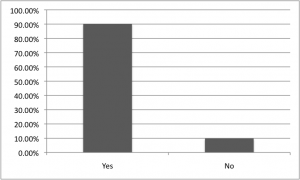
Facebook page - Generation Y
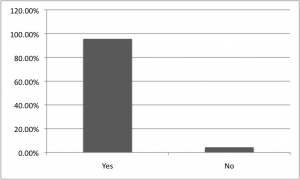
Facebook page - Generation Z
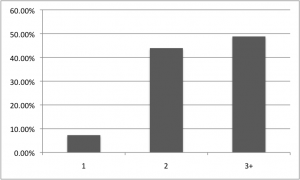
Number of computers owned - Generation Y
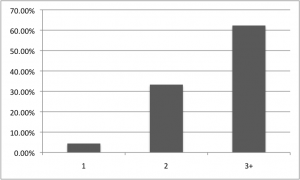
Number of computers owned - Generation Z

Agreement with generational characteristics - Generation Y

Agreement with generational characteristics - Generation Z

Percentage of correct answers to historical quiz - Generation Y
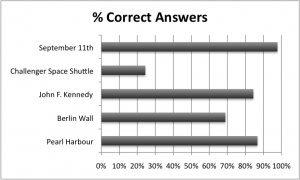
Percentage of correct answers to historical quiz - Generation Z
Students are learning more, but in danger of info overload
January 14, 2010 by Mitch Thompson · Leave a Comment

The overall population breakdown of Kwantlen Polytechnic University, based on age.
Almost half of Kwantlen students are members of Generations Y and Z, according to figures from the Institutional Analysis and Planning department, and were born into a world of personal computers and an explosion of information.
Generation Y includes people born between 1980 and 1989; Generation Z is those born in 1990 and subsequent years. Student records show that 48.8 per cent of Kwantlen students were born between 1988 and 1992.
The Y and Z designations came from a need for a distinction between the Baby Boomers, who were born after World War Two, and their children, who were born between 1965 and 1980. Those children have been called the “after-boomers.â€
Canadian author Douglas Coupland coined the phrase Generation X in his 1991 novel Generation X: Tales for an Accelerated Culture. He believed the title signified the seemingly contradictory ways of post baby-boom society.
The name caught on,and the Y and Z labels followed.
According to an article on About. com, a New York Times-run website, Gen-Yers value family time and teamwork. Generation Z, however, is more individualistic and puts less stock in family values, according to an article in Australia’s Herald Sun.
But there is one overarching value that the generations share.
“The main value, given their age, is probably a thirst for knowledge and looking for means of meaningful self-expression,†said Peter Clayton, a Kwantlen instructor whose courses focus on media and sociology.
This need to know manifests itself in the widespread use of the Internet to discover information and communicate ideas to others.
“The more serious-minded of them spend an enormous amount of time online in the quest for knowledge,†said Clayton.
The older ways of researching, using libraries and books, are slowly being phased out in favour of websites such as Wikipedia or Google.
It’s a change that allows them to learn while delivering the content in a way that is culturally relevant to them, explained Clayton.
However, this cultural inclination towards technology has created never-before-seen consequences for those of Generations Y and Z.
“The downside of all the information technology is that, as far as
leisure time is concerned, people spend more time on their own,†said Clayton.
Generations Y and Z are characterized by physical isolation.
Though they may be talking to friends online, they are still alone at a computer, which can have a negative effect on how they socialize in public.
“On one hand [their culture] encourages them to be more outward-looking,†said Clayton. “But on the other hand, it encourages them to be more isolated and inward-looking.â€
As well, constant access to the Internet has created two generations that suffer from information overload, Clayton said.
“They are probably a lot more stressed out than they realize,†he said. The two generations have become walking dichotomies, Clayton believes, as they want to learn as much as possible, but suffer from extreme information overload.
A thrift-store romance: How to impress the other gender when your budget is slender
January 13, 2010 by Mitch Thompson · Leave a Comment
The art of wooing can be expensive, especially for a poor university student, but creativity and a little pocket change can go a long way.
According to Sheree Morgan, a Vancouver-based professional matchmaker, the best place to start looking for value dates is away from screens or dinner tables.
“The best place for low-budget ideas is outdoors,†Morgan said.
With the large number of walking paths, hiking trails and parks in the Lower Mainland, there is something for all fitness levels.
Remembering your date’s physical prowess is important, as Soraya Raiszadeh, a Kwantlen student, knows well.
The thrifty outdoor excursion Raiszadeh went on included the infamous Grouse Grind.
“I wouldn’t say it was the best way to go on a date,†she joked.
Raiszadeh is one of 13 Kwantlen students asked by the Chronicle about the cheapest, most effective date they had been on. For the purpose of the poll, “effective†means that it lead to other dates, or was enjoyed by both parties.
Dana Stasyk, a first-year Public Relations student, was also courted outdoors. She was in Australia and, met a man named Pok, who took her for a stroll on the beach. “He had laid down a picnic at the end of the walk,†said Stasyk. “It was very sweet.â€
Romantic as woodland walks can be, Morgan does have one important tip. “Make sure you stick to the paths,†she cautioned. “It really kills the moment if you have to be rescued. Probably not a great way to end the date.â€
Going outside is one way that dates can be cost-efficient. The other involves a bit more inventiveness.
“Women love it if you’re a little bit creative,†said Morgan.
She used a past date she had been on to emphasize her point. “After a fresh snowfall, dress up really warm, take a thermos of hot chocolate and go to Stanley Park. I’d never done it before, and it’s probably one of the most wonderful things I’ve ever done,†she said. “It didn’t cost any money, it just took a little bit of thought.â€
Kaitlyn Cook, one of the interviewed Kwantlen students, also enjoyed a date that was simple, but memorable. Her date took her skating, but was absolutely awful at it. Luckily, Cook used to figure skate and they spent the date with her teaching him. “I don’t know, maybe he was faking, but it still made me feel special,†she said.
In fact, almost all of the students polled enjoyed the simple dates as much or more than the most expensive ones they had ever been on.
Ryan Cardoz, a business student, once took his date to Costco for hot dogs. The whole meal cost him a wallet-destroying $3.20.
“It was pretty effective,†Cardoz said. “We were both poor at the time.â€
The date was so good, he ranked it as high as the $240 meal at a downtown restaurant to which he later took the same woman.
Echoing his statement was George Pauol, a psychology major, who felt that the day trip he took with his girlfriend to Victoria was less enjoyable than just walking around the mall with her. He said that because of all the tourist attractions, they were both distracted and there was less time for conversation.
For many of those polled, good conversation with a person who would listen and make them laugh was essential to ongoing interest.
“Be very talkative, because I am a chatterbox,†said Rasizedah.
“As long as we can talk without feeling awkward, it’s cool,†said Alvin Denbock, a business student.
“If she’s interested in me, it makes her seem interesting,†said Cardoz.
“Make me laugh and you’ll get a shot. Don’t make me laugh, and you’ll never see me again,†said Cook.
Can several dollars worth of hot dogs and good conversation really be the Holy Grail of thrifty dating?
Morgan, the matchmaker whose focus is on finding clients a single, compatible match, agrees with the conversation part. “Be as positive as possible. Make it fun. We all want to be around somebody who is confident,†she said.
According to one of the polled students, it’s not about the content of the date, but the quality of the person next to you.
Anatomy of a virus: A biological breakdown of H1N1
January 13, 2010 by Mitch Thompson · Leave a Comment
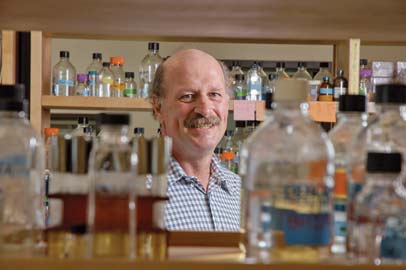
File Photo of Dr. Hancock (Courtesy of UBC Media Services)
Strange mutations, odd biological behaviour and the potential to become more deadly have catapulted H1N1, better-known as swine flu, into the scientific limelight.
With the threat of a more deadly version of the virus on the horizon, scientists are trying to understand how this virus came to be, and what it will become.
A team of UBC researchers has made interesting discoveries about H1N1 by studying a different virus: the one that causes avian flu.
The team has been studying how avian flu causes inflammation, and compared it with similar viruses, including H1N1.
“Intrinsically, swine flu doesn’t have the ability to cause inflammation as strong as avian flu,†explained UBC microbiology professor Bob Hancock.
Hancock described H1N1 as “somewhat less harmful and lethal than even the normal seasonal influenzas usually are.â€
However, the British Columbia Centre for Disease Control reports five deaths related to swine flu.
The cause of such deaths could be revealed by research Hancock’s team is doing into systemic inflammation.
“[The viruses] have on them… molecules that are recognized as ‘foreign’ by receptors inside cells, which turns on the inflammatory process,†said Hancock.
This process is a natural defense against these foreign objects, but the trouble comes when flu virus gets into the lungs. The inflammation that occurs can spell disaster if it continues for too long.
“Inflammation in the lungs… causes a lot of fluids to come into the lungs. People literally drown from their own fluids,†said Hancock.
In addition, the virus can worsen secondary infections and cause death, as shown by the 1918 Spanish Flu, which was also a form of H1N1. More than 20 million people died in that outbreak, according to the World Health Organization. Antibiotics had not yet been invented.
Seniors with age-related, health complications are vulnerable to flu-induced complications, but that may not be the case with H1N1.
“Elderly people have seen an H1N1 type virus before. I think the
last outbreak was in the ’70s,†said Hancock. “They tend to have some immunity to this virus…balanc[ing] off the sort of increased susceptibility.â€
A young, healthy person’s lack of existing antibodies may put them at higher risk than someone who was exposed in the past.
However, past exposure and the resulting antibodies don’t necessarily rule out infection, as the swine flu of 1918 and 1970 was not exactly the same as the swine flu of today.
“Flu has the ability to undergo a variety of processes that can change it…so that our body no longer recognizes it,†explained Hancock.
These changes of form are the reason people must be re-immunized every year.
Scientists use the system of H1N1 to categorize various flu strains by the sequence of hemagglutinin (H), the molecule that binds the virus to cells, and neuraminidase (N), the molecule that cuts free freshly made virus cells.
Some strains have similar sequences (swine flu is H1N1, avian flu is H5N1), so they are grouped together although they are biologically different.
The viruses categorized as influenza A, of which swine flu is one, generally have a hard time infecting humans, but H1N1 found a way to adapt itself to allow easy human-tohuman transmission.
“What it looks like is a farm worker managed to acquire two strains of influenza from pigs, and they went through a process known as reassortment,†said Hancock.
The two viruses swapped bits of each other until a new one was eventually created.
The union produced a certain strain that is easily transmitted between human beings.
“It’s really new, and people don’t really have an existing immunity,†he said. “There’s substantial concern that it could mutate in a way that would allow it to become more deadly.â€
Kwantlen mascot needs a name
January 13, 2010 by Kirk Darbyshire · 1 Comment
The Kwantlen Eagles mascot is in need of a name and the athletics department is challenging students to come up with it, offering an iPod touch to the winner.
The mascot, which was designed by a collaboration of student opinions, is a giant eagle that has been nameless since its first appearance last September at a school sporting event.
“We feel that this is a great opportunity for students to get involved and show their school spirit,†said Katlyn Moore, Kwantlen’s athletic director.
The contest requires students to submit their suggested names to the athletic department web site before the Jan. 15 deadline. Once all the name ideas have been reviewed, the athletics department will post the 10 finalists on the Kwantlen website and students will be able to vote for their favourite.
“The response has been really good,†said Moore, who claims there have been over 60 unique names suggested already.
The winning name will be announced on Jan. 29 at the same time as the school raises the Kwantlen women’s soccer team’s championship banner in the Surrey gymnasium prior to both the men’s and women’s basketball games against Vancouver Island University.


